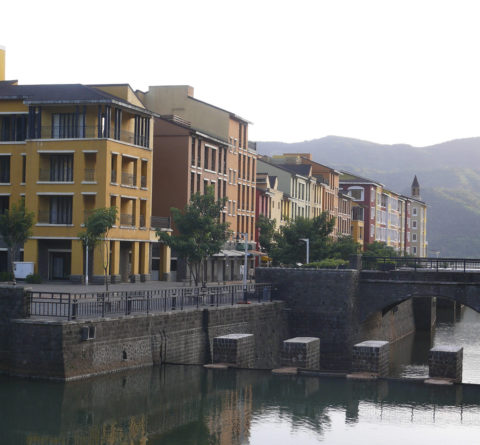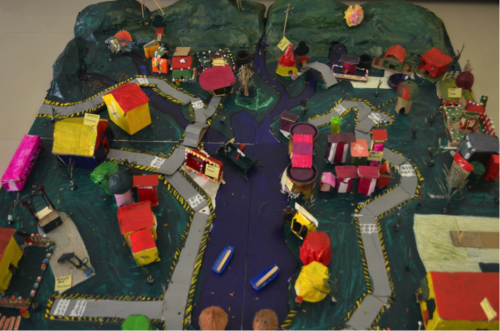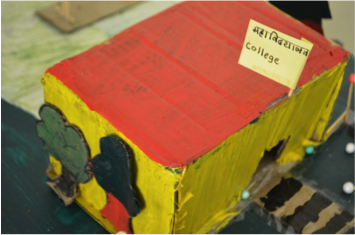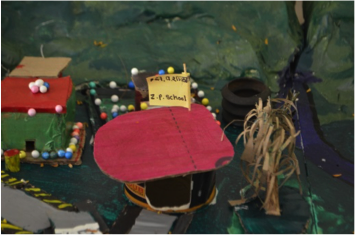Living on the land of urban transformation
Dr. Sophie Hadfield-Hill and Dr. Cristiana Zara report on findings from the ESRC-funded ‘New Urbanisms in India’ project, researching children and families’ experiences of urban transformation. Lavasa, a private-led city development currently under construction in the Indian state of Maharashtra, was the focus of the research. At a time of significant urban change in India, where the Indian government is pursuing a Smart Cities Mission, this is an opportune moment to investigate children and families’ lives at sites of urban change, those who are living in, interacting with, moving through and negotiating a new urban life. This blog focuses on one aspect of the research, the ‘My City’ vision for urban development; a model built by 130 children and young people. The findings are born out of their vision for the next phase of the Lavasa development in a particular space and moment in time. However, there are broader lessons to be learnt for other sites of urban transformation in considering the importance of connections, education, nature and participation.

A neoliberal urban agenda, characterised by a vision for Smart City development, is currently being pursued in India. The first 20 cities have been selected, and the retrofitting and development of greenfield sites has begun. At a time when promises are being made in terms of environmentally and technologically driven solutions to urban ills, from water and sanitation to transport and sewage, it is important to pause and consider the perspectives of children and families, who have in recent years experienced considerable upheaval to their land and livelihoods. The vision of Lavasa is to build ‘five self-sustaining towns with a permanent population of 300,000 residents … [with] award winning urban design developed on the principles of New Urbanism’, with the management advocating ‘urban life with rural advantages’, connectivity, diversity, mixed housing, walkability and sustainability. However, the development has been marred in controversy since its inception over issues such as land acquisition, environmental clearances and more recently financial turmoil. This has had significant implications for people and place, and whilst we are not repeating these disputes here, we acknowledge the ongoing politics which shape the everyday experience of those who live, learn, work and play in this space. Here we focus on those families who had a connection to the land and its past. The following discussion is based on four themes which emerged from the qualitative research and were reflected in a final output of the project, the ‘My City model’, a city plan based on the perspectives and everyday experiences of 130 children and young people.
First, a brief note on the model building methodology: the ‘My City’ workshops emerged from 11 months of ethnographic, participatory research. Formulated by young people themselves, the concept was to create their vision for the next phase of the development, using recycled materials. A self-selecting group of ‘planners’ worked on the overall plan for the development, each specialising in a particular element of the vision (i.e. themes of nature, transport, play, houses, education and facilities). They then liaised with the ‘builders’ to construct the model buildings, the roads and trees. There were three ‘My City’ workshops with children and young people aged 9-14; adult stakeholders involved in the urban design and architecture for the development also participated, listening and working with the young participants to plan and construct their vision. The final model can be seen in Figure 1.

Figure 1. ‘My City’ model reflecting children and young people’s visions for the future phase of development, based on the themes of nature, transport, play, houses, education and facilities.
The importance of connection in mapping, materializing and envisioning urban development
A central theme of the research was children and families’ encounters with (dis)connection; everyday experiences of being materially, socially and metaphorically (dis)connected to the urban vision. Children’s experiences were embodied through material connections with electricity wires, solar panels, water tanks and concrete; they were symbolically and materially wired with Lavasa. However, their experiences of these connections varied across time and space. Children’s vision for future phases of development show that, i) villages must be connected by well-maintained roads and paths, and ii) water pipes, electricity and sewerage systems must reach all areas. Children and their families experienced numerous vulnerabilities due to disconnections ranging from transport to water and electricity. Connections were vital for belonging and livelihood. Many of these experiences were temporal, with the greatest difficulties being during the monsoon. Participants felt that ‘urban advantages’ needed to be more consistently implemented throughout the site, minimising the challenges encountered through disconnection. This further justifies the appropriate construction of roads to prevent the heavy rain washing away vital links between people and place. Thus, building and maintaining connections between diverse urban spaces is crucial for social and economic prosperity.
Education provision: a vital component of urban planning
For children and their families, education was an enabler of urban life and underpinned their decision to move to Lavasa, to commit to a new place. Young people recognised that a diversity of educational facilities are needed to ensure that all livelihoods and aspirations are catered for: importantly, these need to be well-connected when planning the development. This is symbolised in the ‘My City’ model through a range of public and private education options being provided, mapping the entire educational career, across the socio-economic spectrum (see Figure 2). Young participants also made sure that each of the educational establishments on their model were adequately connected, in terms of roads and electricity, with schools and housing in close proximity. It is essential that new urban environments (of whatever scale) have a diverse education strategy at their core. From nurseries to higher education, to suit all social backgrounds, children recognised that provision is needed at the outset, in a way that grants sustainable continuity across young people’s lives.


Figure 2: A diverse range of education options are needed to ensure family commitment and belonging to sites of new urban development, for example, higher education colleges and government primary schools as shown in the model.
Landscapes of memory at sites of urban change
Given the geographical setting of Lavasa, in the western Ghat mountain range, it is not surprising that participants felt deeply connected with the natural surroundings. While their experiences of nature were diverse, all ages across the socio-economic spectrum gave vivid accounts of the importance of nature for family, friendship, self-identity and wellbeing. Children and young people frequently spoke about co-belonging and co-existing with nature and animals. Young people growing up in this shifting landscape of urban change had an overwhelming sense of stewardship for the natural environment surrounding them. This was particularly evident when the planning team were designing the model: nature and natural aspects of the landscape were the most important elements to be preserved. The majority of these children had a relationship with the land prior to the new development, connecting them with its past: remembering and retaining this history is an important part of urban change.
Participation: remembering the citizen in the Smart City project
Many families who took part in this research were involved in the construction of the urban form – for example, in building and laying the roads. Indeed, many of them had given their land to accommodate the new development. From working with these children and families, it is evident they had a vision for what they wanted their city to look like. Through planning, designing and building a model of the next phase of the development, the children showed that they had dreams and visions for this space too. Indeed, as one of our young participants, an eleven-year-old girl, commented: ‘we take part in building the[se] buildings… [to] give more ideas how to make the city more attractive’.
However, through the research we came across multiple disconnections in terms of who the vision of Lavasa was for – who was connected and who was not, who was counted as a citizen and who was not, who was educated and who was not, who spoke and who was heard. There are significant opportunities both in the Lavasa development and within the Smart City agenda for people to participate and be included. Urban development is complex; however, what is clear is that in an age of a neoliberal Indian urban vision, sites of urban change should not be planned, designed and built without a consideration of the everyday lives, needs and desires of children and their families, particularly those who have a claim to its land and its past.
Dr. Sophie Hadfield-Hill (PI) is a lecturer in Human Geography at the University of Birmingham; Dr. Cristiana Zara is the Research Associate working on the project. The researchers lived for most of 2015 in the case study site, conducting research with 40 families from diverse backgrounds, which involved 160 interviews, children’s drawings, participation in My City workshops and the use of an innovative mobile app ‘Map my Community’. Over 350 participants were involved in the project, which sought to understand the lived experiences of urban change from the perspective of children, young people and their families.